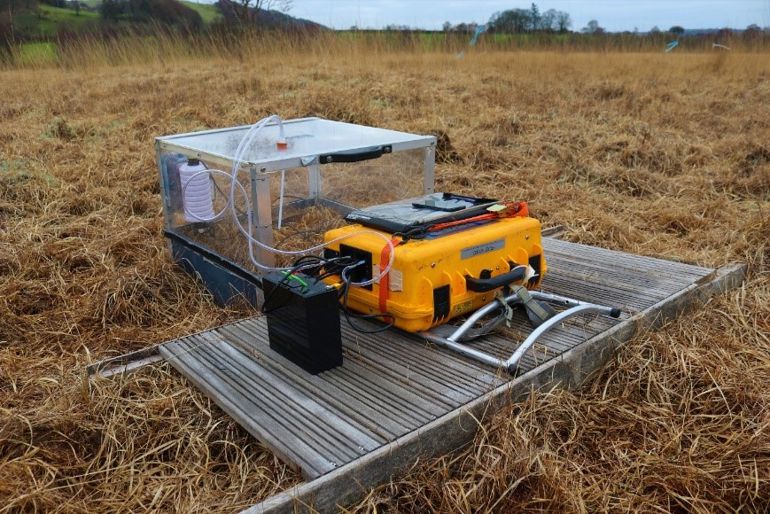Blog from the bog - Learning whilst working

Joanna Kowalska plays a key role in assisting the Natural Resources Wales’ LIFE Welsh Raised Bogs Project team. As part of her role she has been taking part in greenhouse gas monitoring work for the project.
Here she talks about the work and what she’s learnt so far.
I consider myself lucky that in my role I can further develop my skills and knowledge of the science behind climate change.
Apart from working for the project, I am also a postgraduate student of Sustainable Food and Natural Resources at the Centre for Alternative Technology and I am currently researching the impact of various plastics on our precious aquatic ecosystems.
I started with the project back in 2019 and I help the team with all sorts of work, including communications, administration and restoration work monitoring.
The monitoring work for the project is done in collaboration with the UK Centre for Ecology & Hydrology (UKCEH) and involves us as a team going out on site several times a month to collect data, which is then sent to UKCEH for analysis.
Greenhouse gas monitoring is an important and intricate part of the monitoring work, and it helps us to measure how much carbon and methane is stored or released in the peatlands that we are restoring.
Carbon storage potential
Healthy peatlands and raised bogs in good condition absorb greenhouse gases such as carbon dioxide (CO2) and methane (CH4) from the atmosphere and lock them away. For this reason, as well as their biodiversity, recreational and other benefits, they are important in the fight against climate change.
In fact, peatlands are the largest natural terrestrial carbon store. The area covered by near natural peatland worldwide (more than 3 million km2) stores more carbon than all other vegetation types in the world combined.
However, damaged peatlands are also a major source of greenhouse gas emissions, annually releasing almost 6% of global anthropogenic CO2 emissions.
This is why the LIFE Welsh Raised Bogs project looks at new and innovative ways of working to restore the seven raised bog Special Areas of Conservation (SACs) in Wales.
Greenhouse gas monitoring – how is it done?
As part of the peatland restoration work monitoring, the project, together with UKCEH, is carrying out greenhouse gas (GHG) monitoring on Cors Caron near Tregaron. The GHG monitoring will provide data concerning changes in CO2 and CH4 before and after the restoration work.
The GHG monitoring takes place on Cors Caron, where UKCEH installed 30 of the so-called ‘collars’ (grey frame pictured below).

A clear chamber is placed on each of the 30 collars, and a portable greenhouse gas analyser is connected to the chamber (the GHG analyser is the yellow suitcase in the below image).

The clear chamber allows for a maximum transmission of sunlight, and the test carried out with its use provides measurements of net ecosystem CO2 exchange (NEE). NEE allows us to estimate the exchange of CO2 between the bog and the atmosphere, and this will provide findings on how well the bog is storing carbon.
On every collar, the greenhouse gas analyser records greenhouse gas concentrations from the clear chamber for 5 minutes, at 1 second intervals.
To obtain additional data, reduced light intensity is simulated by covering the clear chamber with one of three shade cloths at a time (pictured below) and the GHG concentrations are then recorded for additional 5 minutes per each shade cloth.

Finally, a tarpaulin which blocks out all light is placed on the clear chamber (as pictured below) and GHG concentrations are measured for further 5 minutes – this is called a ‘dark test’ and it provides estimates of ecosystem respiration (ER). ER provides us with information on CO2 uptake and release into the atmosphere by the bog through the process of photosynthesis.

The process of recording GHG concentrations inside the chamber (with first the clear chamber, then with each of the three shade cloths and the tarpaulin) is repeated on every one of the 30 collars on Cors Caron.
Additionally, variables such as air temperature, soil temperature and soil moisture content are also recorded for every collar.
Each month, the team completes three full days of work on site to gather the GHG data. We then submit the collected data to UKCEH, where it undergoes scientific analysis and will soon be shared in the project’s first Mid-Term Report. We hope to share Some of the results from this report with you this summer.
In the meantime you can keep up to date with the projects progress on the LIFE Welsh raised bogs project please visit the website or please go to the Facebook page @CyforgorsyddCymruWelshRaisedBogs or Twitter @welshraisedbog
